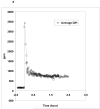A non-invasive, on-line deuterium dilution technique for the measurement of total body water in haemodialysis patients
- PMID: 18326883
- PMCID: PMC5207314
- DOI: 10.1093/ndt/gfn045
A non-invasive, on-line deuterium dilution technique for the measurement of total body water in haemodialysis patients
Abstract
Background: Despite its importance, total body water (TBW) is usually estimated rather than measured due to the complexity of isotope dilution methods. The aim of this study was to demonstrate the applicability in haemodialysis (HD) patients of a recently developed on-line breath test, previously validated in healthy subjects, that uses the gold standard deuterium dilution method to measure TBW. In particular we wished to show that a pre-dialysis estimation was as good as a post-dialysis equilibrated measurement in order to avoid patients needing to remain behind after dialysis treatment.
Methods: The dispersal kinetics of breath HDO, measured using a flowing afterglow mass spectrometer (FA-MS) following ingestion of D(2)O immediately post-dialysis, were determined in 12 haemodialysis patients and used to calculate the absolute TBW(PostHD) after full equilibration. TBW(PreHD) was then determined from breath samples taken immediately prior to the next dialysis. This measurement was adjusted for the interdialytic weight change and urine output (TBW(PreHD-adjusted)) and compared to the TBW(PostHD). The accuracy and precision of FA-MS was also assessed using known concentrations of deuterium-enriched water samples.
Results: Mean TBW(PostHD) was 50.0 +/- 9.3 L and TBW(PreHD-adjusted) was 50.7 +/- 9.0 L. They were highly correlated (R = 0.99, P < 0.001) with a CV of 2.6%. The mean difference was +0.74 L (SEM 0.35, 95% CI -0.03 to 1.51 L, P = 0.059), compatible with a daily insensible loss of 0.37 L. Accuracy and precision of FA-MS were comparable to the previous validation work.
Conclusions: This non-invasive adaptation of the D isotope dilution method for determining TBW can be applied to haemodialysis patients who show deuterium equilibration kinetics identical to normal subjects; a pre-dialysis estimation may be used to determine TBW, and so avoiding the necessity to remain behind after dialysis making this suitable for application in the clinical setting.
Figures






References
-
- Schoeller DA, van Santen E, Peterson DW, et al. Total body water measurement in humans with 18O and 2H labeled water. Am J Clin Nutr. 1980;33:2686–93. - PubMed
-
- Arkouche W, Fouque D, Pachiaudi C, et al. Total body water and body composition in chronic peritoneal dialysis patients. J Am Soc Nephrol. 1997;8:1906–14. - PubMed
-
- Schoeller D. Hydrometry: Body Composition Measurement Methods. In: Heymsfield SB, Lohman TG, Wang ZM, Going SB, editors. Human Body Composition. 2nd ed. Human Kinetics; 2005. pp. 35–50.
-
- Davies S, Spanel P, Smith D. Rapid measurement of deuterium content of breath following oral ingestion to determine body water. Physiol Meas. 2001;22:651–9. - PubMed
-
- Smith D, Spanel P. On-line determination of the deuterium abundance in breath water vapour by flowing afterglow mass spectrometry with applications to measurements of total body water. Rapid Commun Mass Spectrom. 2001;15:25–32. - PubMed
Publication types
MeSH terms
Substances
Grants and funding
LinkOut - more resources
Full Text Sources
Other Literature Sources
Medical

